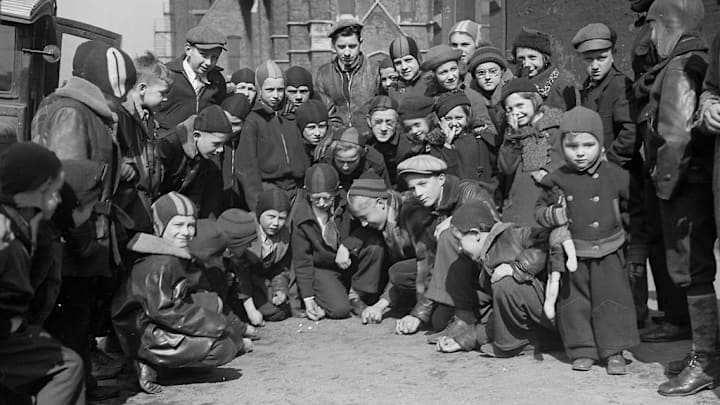Many kids’ games have no exact traceable origin. Children seem to come up with familiar ways to play no matter what time or place they live in. Even though it’s hard to pinpoint precisely where all these games originated, there’s some incredible history behind the playground games you loved as a child.
1. Jacks
Jacks are at least as old as ancient Greece, except at that time the jacks and ball were tiny sheep bones or rocks. It was still the same idea: toss and catch the jacks in a prescribed fashion—only, for most of history, it was called Knucklebones.
2. Red Rover
One theory is that Red Rover, with its distinctive chant, was named after an 1828 steamboat that took passengers back and forth across the Hatchie River. Another suggests it was a taunt early English children directed at Viking invaders.
3. Blind Man’s Bluff

Blind Man’s Bluff became especially popular in Tudor England, even among adults. The game was even said to be a favorite in the court of Henry VIII.
4. Tetherball
Depending whom you ask, tetherball is either an offshoot of the romantic Maypole, or it evolved from a game played by the 9th century Tatars that was a lot like tetherball but used pieces of vanquished enemies as the ball.
5. Kickball
Kickball was invented in Cincinnati in 1917. It was also called Kick-Baseball and Soccer-Base. Its accessibility as an organized sport for even small and uncoordinated children was quickly recognized. By the early 1920s, P.E. teachers all over America had begun using kickball as a standard practice in gym class.
6. Hopscotch

Some sources state that hopscotch began in Roman-ruled England. The courses were 100 feet long and were used by Roman soldiers to build agility while wearing full armor. The scotch in hopscotch attached itself later. It’s an English variation of scratch, in that players were hopping over scratches made on the ground.
7. Marbles
Marbles are ancient and have been found in pharaohs’ tombs and in Aztec ruins. There is no one way to play marbles—every schoolyard has its own rules. The classic version of marble-playing we know today came into existence in the early part of the 20th century, when mass production made it possible for children to buy whole bags of beautiful glass marbles for just pennies.
8. Mumblety-peg
Depending on whom you ask, this game either originated in 17th century England or 19th century America. Mark Twain mentioned it as one of Tom Sawyer’s favorite activities, and the image of young boys tossing pocketknives at their feet and then removing them from the dirt with their teeth (making them mumbly) feels distinctly Twain-ian.
Read More Stories About Your Favorite Childhood Games:
9. Capture the Flag
Though no one has traced the precise beginning of capture the flag, it is most likely a child’s re-creation of a battlefield. In many military cultures, the battle is not won until you are in possession of your opponent’s actual flag.
10. The Farmer in the Dell
This game, where children form a circle and in turn pick farmers' wives, children, dogs, servants and cheese, probably originated in Germany in the 1820s. It was a courtship game played by adults originally, then became popularized in America by German immigrants. A dell, by the way, is a small wooded valley.
11. London Bridge Is Falling Down
The London Bridge has existed in one form or another since the Roman occupation, and it has fallen down many times. Some believe the game that accompanies the rhyme grew from a widespread tradition of bridge dances popular in the Middle Ages. Some historians also believe that the rhyme itself refers to a superstitious practice of killing and burying a child at the bridge site to keep it from collapsing.
12. Double Dutch

Double Dutch, where jump ropes are whirled opposite each other, is thought to have evolved from the way ancient rope makers made their product. Workers tied the ropes to their waists and a large wheel, wrapping strands as they walked backwards. Supply runners would have to jump these ropes when slack to make their deliveries.
13. Croquet
Croquet originated in 11th century France, where it was called jeu de mail. The croque is related to the French crochet, which can mean “crook,” likely the shape of the stick first used for mallets.
14. Shuffleboard
Shuffleboard has been around for at least 500 years. Henry VIII is said to have forbid his archers to play the game because it diverted their attention from their archery practice. It was originally played with shovels, and coins were used instead of pucks. The evolution of the name “Shuffleboard” is a neat study of etymology: shovelgroat … shoveboard … shovelboard … shuffleboard.
15. Foursquare
Foursquare likely had ancient origins, but the version children play today came to popularity after the 1940s. It was originally called “boxball” because of the quadrants used, and it was especially popular in urban areas where there wasn’t enough room to play other traditional ball games.
A version of this story ran in 2014; it has been updated for 2024.
